4 Must-Haves in a Healthy Grocery Cart
These days, healthy living is easier than ever. With services like Cuisinery Food Market making quality ingredients accessible, you don’t even have to step into a supermarket to find healthy products. However, with such a wide range of choices, how can we decide what we need?
According to the USDA’s nutritional resource MyPlate, the five main food groups the body needs are fruits, vegetables, grains, protein foods, and dairy. No single food group is rich enough to contain everything the body needs, so it’s important to incorporate a diverse range of food into your diet. Below, we’ll dive into each food group to help you determine what products you need to add to your healthy grocery cart.
1. Fruits and vegetables: Make a rainbow plate
Fruits and vegetables should be a staple in your daily meal plan. But you can’t just stick to one and call it a day. According to a study on NCBI, fruits and vegetables derive most of their health benefits from compounds known as phytonutrients, which also give them their unique colors. For instance, red fruits and vegetables, such as apples, strawberries, tomatoes, and red onions, contain the compound carotenoid lycopene, which protects the body against heart and lung disease. Meanwhile, green, leafy foods like broccoli, spinach, and cabbage contain the cancer-blocking chemicals sulforaphane, isocyanate, and indoles. Since different colors offer different nutrients, you can only get the full range of health benefits by diversifying the colors in your grocery cart.
2. Grains: Whole over processed
Your grains are always better whole rather than processed. When grains are refined, they lose useful nutrients like fiber, iron, and vitamin B. And note that these play a huge part in maintaining your body's internal functions. So instead of white rice, white flour, and white bread, stack your cart with brown rice, quinoa, wheat berries, or oatmeal. You might even find whole-grain wheat and pasta. Whole-grain foods contain the nutrients mentioned above as well as antioxidants, which stave off cell damage and reduce your risk of catching diseases like stroke, diabetes, and heart disease.
3. Proteins: Lessen red meats
Proteins contain amino acids, which facilitate muscle and bone repair, provide energy, and create the red blood cells to carry oxygen through the body. However, many sources of protein have negative effects that outweigh their merits. Cured meats, for example, are particularly rich in sodium. One of the articles by wellness publication SymptomFind touches on the negative effects of sodium. The article explains that sodium increases your risk for diabetes, high blood pressure, and heart problems. So, protein alternatives that contain less sodium, such as fresh fish, chicken, or turkey, are much healthier options. Your chickpeas, lentils, and beans are also packed with protein, making them a good substitute for those on plant-based diets.
4. Dairy: Go plant-based
According to Got Milk, cow’s milk contains a number of healthy nutrients, including calcium, potassium, vitamin B12, and protein. However, if you’re lactose intolerant, vegan, or simply not a fan of milk, dairy alternatives can offer the same set of nutrients while also having less sugar levels. Cashew milk and almond milk, for instance, are high in calcium as well as vitamin D and E. Though if you're not a fan of nut milk, you can instead opt for oat milk. It has similar nutrients to cow's milk while also having beta-glucans, which lower blood cholesterol levels.
Each food group is just a piece of a larger puzzle. As such, your body will only function at its best when you provide it with a complete set of nutrients. Protect your body from disease, infection, and underperformance by filling your grocery cart with all the food groups you need for a healthy diet.




